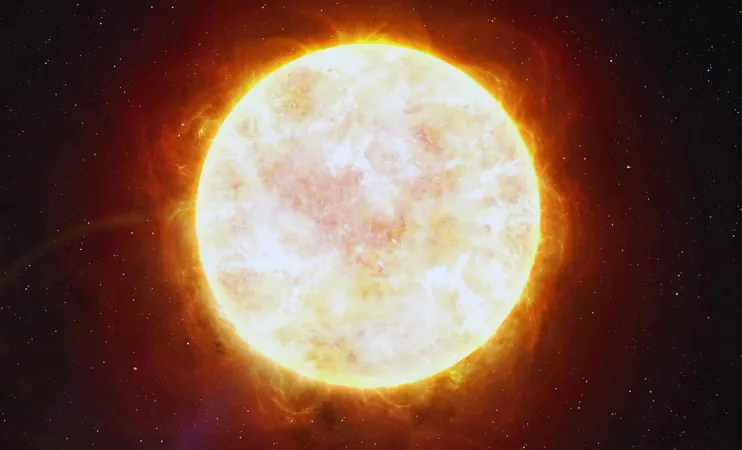
The Sun's Shocking Rebirth: Is Our Star Waking Up?
2025-09-17
Author: Benjamin
A Stunning Revelation from NASA
In a groundbreaking study featured in The Astrophysical Journal Letters, NASA researchers have unveiled a stunning twist in solar dynamics: our Sun, once thought to be entering a prolonged hibernation, has been dramatically increasing its activity since 2008. This revelation, spearheaded by Jamie Jasinski at NASA's Jet Propulsion Laboratory, upends previous assumptions and reignites the intrigue surrounding our nearest star.
A Surprising Reversal
Just a few years ago, solar scientists were almost unanimously convinced that the Sun was sinking into a major period of low activity. From the 1980s until 2008, key indicators such as sunspot counts and solar wind strength showed a consistent decline, with 2008 marking the record low for solar activity. Analysts were bracing for a potentially decades-long minimum reminiscent of the historically calm periods of the 1600s and early 1800s. However, in a shocking twist, the Sun has not only halted its decline but has now reversed course. Jasinski remarks, "All signs were pointing to low activity, so it was a surprise to see that trend reversed. The Sun is slowly waking up."
Why Should We Care About Solar Activity?
This surge in solar activity doesn't just excite astronomers—it holds serious implications for life on Earth. With solar flares and coronal mass ejections becoming more frequent, the stability of our technologies—like GPS, communication systems, satellites, and power grids—could be at risk. NASA is particularly vigilant as it prepares the Artemis program, which aims to return astronauts to the Moon and eventually Mars. An active Sun means heightened radiation levels, raising risks for space crews. Thus, understanding the Sun's behavior is crucial, not just for scientific knowledge but for ensuring human safety.
A New Era of Solar Monitoring Begins
To tackle these challenges, NASA and NOAA are launching a series of missions on September 23, including IMAP, the Carruthers Geocorona Observatory, and SWFO-L1. These missions are designed to collect vital data, enhance space weather forecasting, and ensure scientists can stay ahead of whatever the Sun throws our way.
Decoding the Sun's Mysteries Across Centuries
While the Sun's activity typically follows an 11-year cycle—a predictable pattern—the longer trends spanning decades or centuries remain enigmatic. The Maunder Minimum, from 1645 to 1715, marked a 70-year stretch of unusually low solar activity, and a similar phenomenon occurred between 1790 and 1830. Yet, the reasons behind these cycles elude understanding. According to Jasinski, "We don’t really know why the Sun went through a 40-year minimum starting in 1790... the longer-term trends are a lot less predictable and are something we don’t completely understand yet."
A Turning Point in Solar Research
The year 2008 served as a critical pivot in solar research. Many experts anticipated a long, quiet phase reminiscent of past events. Instead, the Sun turned the tables. Jasinski's team delved into extensive data from NASA’s OMNIWeb Plus, which aggregates measurements from numerous spacecraft, including the ACE and Wind missions initiated in the 1990s.
These missions act as health monitors of the Sun, tracking metrics like solar wind speed, plasma temperature, and magnetic field strength. Surprise! Since 2008, these indicators have been on the rise. It appears that far from settling down, our Sun is gearing up for something remarkable.









 Brasil (PT)
Brasil (PT)
 Canada (EN)
Canada (EN)
 Chile (ES)
Chile (ES)
 Česko (CS)
Česko (CS)
 대한민국 (KO)
대한민국 (KO)
 España (ES)
España (ES)
 France (FR)
France (FR)
 Hong Kong (EN)
Hong Kong (EN)
 Italia (IT)
Italia (IT)
 日本 (JA)
日本 (JA)
 Magyarország (HU)
Magyarország (HU)
 Norge (NO)
Norge (NO)
 Polska (PL)
Polska (PL)
 Schweiz (DE)
Schweiz (DE)
 Singapore (EN)
Singapore (EN)
 Sverige (SV)
Sverige (SV)
 Suomi (FI)
Suomi (FI)
 Türkiye (TR)
Türkiye (TR)
 الإمارات العربية المتحدة (AR)
الإمارات العربية المتحدة (AR)